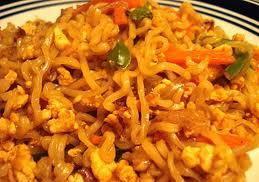Whole wheat rotis are consumed pretty regularly in Indian households. I've not been able to get definitive GI and GL values for rotis, but I think if you eat 3 phulkas (small indian flat bread made of wheat. No fat added in cooking), you get about 270 calories and a glycemic load all put together of about 20-25.
In terms of calories consumed, this is not bad. Unless, you eat it with something else that is really heavy. But the glycemic load is pretty high and one way of fixing this is to switch to a misi roti, which is made of one part atta (wheat flour) and one part besan (chickpea flour). Besan is much lower than atta on the glycemic index, so the average of the two will give you a better GI value. Also, besan is more filling, so you'll probably end up eating fewer rotis. So all in all, it's a great idea. Here's the data.
However, even if you combine both flours, you still get a glycemic load of about 18 (remember the ideal is 10). So the best thing would be to either eat just two rotis or eat three rotis, but add some vegetables to the mix.
The downside is that if you like your roti all soft and fluffy, you won't get that with misi roti, but it's truly a small price to pay. So, here's the recipe for vegetable misi roti (you can omit the vegetables if you like).
Ingredients (Good for about 8-12 rotis depending on the size)
In terms of calories consumed, this is not bad. Unless, you eat it with something else that is really heavy. But the glycemic load is pretty high and one way of fixing this is to switch to a misi roti, which is made of one part atta (wheat flour) and one part besan (chickpea flour). Besan is much lower than atta on the glycemic index, so the average of the two will give you a better GI value. Also, besan is more filling, so you'll probably end up eating fewer rotis. So all in all, it's a great idea. Here's the data.
| |||||||||||||||||||||||||||||||||||||
| |||||||||||||||||||||||||||||||||||||
However, even if you combine both flours, you still get a glycemic load of about 18 (remember the ideal is 10). So the best thing would be to either eat just two rotis or eat three rotis, but add some vegetables to the mix.
The downside is that if you like your roti all soft and fluffy, you won't get that with misi roti, but it's truly a small price to pay. So, here's the recipe for vegetable misi roti (you can omit the vegetables if you like).
Ingredients (Good for about 8-12 rotis depending on the size)
- 1 cup besan
- 1 cup flour
- 1 carrot grated really fine (any other vegetable like radish, or spinach will also be just perfect. No potatoes however)
- 1 onion chopped very fine
- 1 tbsp kasuri methi(dried fenugreek leaves)
- 1 tsp chili powder or 1 chopped green chili
- A pinch of turmeric
- Salt to taste (add very little salt if you are going to eat the rotis with some other salted item)
Method
Mix all the ingredients and add boiling hot water slowly. Mix the dough with a spoon until it it makes a hard dough. Then you can let it cool down a bit and then knead it with your hands using a little lukewarm water at a time until you get softer dough that you can roll out. Remember that this should not get too wet, or it will stick all over the place.
Roll out the rotis using a rolling pin. You can use wholewheat flour to roll it out.
Then cook the rotis on a preheated skillet. It is better to cook them quickly on a high flame on both sides. Take them off the skillet and apply just a little ghee if you like.
Eat them with any vegetable in gravy, but eat them right off the stove, otherwise they'll lose their softness and become tough and chewy.
Tip: Changing over from chapati to misi roti is a good permanent change to make.


